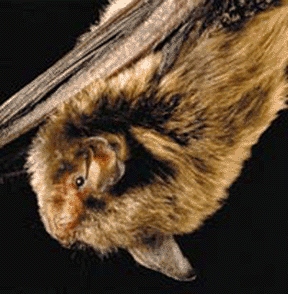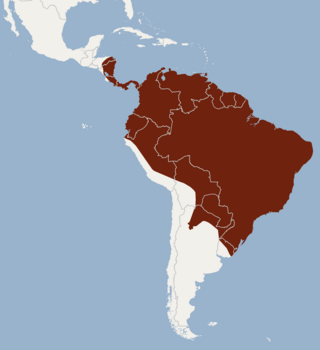
Natterer's bat is a European vespertilionid bat with pale wings. It has brown fur tending to greyish-white on its underside. It is found across most of the continent of Europe, parts of the Near East and North Africa. It feeds on insects and other invertebrates which it catches on the wing or pursues on the ground.

The Indiana bat is a medium-sized mouse-eared bat native to North America. It lives primarily in Southern and Midwestern U.S. states and is listed as an endangered species. The Indiana bat is grey, black, or chestnut in color and is 1.2–2.0 in long and weighs 4.5–9.5 g (0.16–0.34 oz). It is similar in appearance to the more common little brown bat, but is distinguished by its feet size, toe hair length, pink lips, and a keel on the calcar.

The silver-tipped myotis is a species of mouse-eared bat found in a range of lowland habitats in the Americas.

The riparian myotis, is a vespertilionid bat species from South and Central America. It is a medium-sized bat compared to other South American myotis.

Hodgson's bat, also called the copper-winged bat or black-and-orange myotis, is a species of vesper bat in the genus Myotis, the mouse-eared bats. Favouring mountain forests, it is found throughout Central, Southeast, and East Asia, from Afghanistan to Taiwan. It is about 5 centimetres (2.0 in) long and is distinguished from most other species of bat in this range by its yellowish colouration.

The southeastern myotis is a small bat found throughout the Gulf Coastal Plain and the Lower Mississippi Alluvial Plain of the southeastern United States.

The Egyptian slit-faced bat is a species of slit-faced bat broadly distributed throughout Africa and the Middle East. It is a species of microbat in the family Nycteridae. Six subspecies are known.

The greater mouse-eared bat is a European species of bat in the family Vespertilionidae.
The lesser long-fingered bat, also known as the black clinging bat or lesser bent-winged bat, is a species of vesper bat in the family Vespertilionidae. It is found in western Southern Africa, south East Africa, and parts of Central Africa. Its natural habitats are temperate forests, temperate shrubland, and caves and other subterranean habitats.

The Chilean myotis is a species of vesper bat found in southern South America.

The long-eared myotis is a species of vesper bat in the suborder Microchiroptera. It can be found in western Canada, the western United States, and Baja California in Mexico.

The eastern small-footed bat is a species of vesper bat. It can be found in southern Ontario and Quebec in Canada and in mountainous portions of the eastern United States from New England to northern Georgia, and westward to northern Arkansas. It is among the smallest bats in eastern North America and is known for its small feet and black face-mask. Until recently, all North American small-footed Myotis were considered to be "Myotis leibii". The western population is now considered to be a separate species, Myotis ciliolabrum. The Eastern small-footed bat is rare throughout its range, although the species may be locally abundant where suitable habitat exists. Studies suggest white-nose syndrome has caused declines in their populations. However, most occurrences of this species have only been counted within the past decade or two and are not revisited regularly, making their population status difficult to assess. Additionally, most bat populations in the Eastern U.S. have been monitored using surveys conducted in caves and mines in the winter, but Eastern small-footed bats hibernate in places that make them unlikely to be encountered during these surveys. Perhaps as a result, the numbers of Eastern small-footed bats counted in winter tend to be low and they are relatively variable compared to other species of bats. Many biologists believe the species is stable, having declined little in recent times, but that it is vulnerable due to its relatively restricted geographic range and habitat needs.

The fringed myotis is a species of vesper bat that is found in British Columbia, Mexico, and the western United States.

The long-legged myotis is a species of vesper bat that can be found in western Canada, Mexico, and the western United States.

Welwitsch's bat also known as Welwitsch's mouse-eared bat or Welwitsch's myotis is a species of vesper bat native to Africa.

The lesser mouse-eared bat or lesser mouse-eared myotis is a species of insectivorous bat in the family Vespertilionidae.

The long-fingered bat is a carnivorous species of vesper bat. It is native to coastal areas around the Mediterranean Sea, as well as a few patches of land in western Iran. Due to the fact that its population is in decline, it has been listed as Vulnerable on the IUCN Red List since 1988.

Daubenton's bat or Daubenton's myotis is a Eurasian bat with rather short ears. It ranges from Ireland to Japan (Hokkaido) and is considered to be increasing its numbers in many areas.

A maternity colony refers to a temporary association of reproductive female bats for giving birth to, nursing, and weaning their pups. The colonies are initiated by pregnant bats. After giving birth, the colony consists of the lactating females and their offspring. After weaning, juveniles will leave the maternity colony, and the colony itself will break apart. The size of a maternity colony is highly variable by species, with some species forming colonies consisting of ten or fewer individuals, while the largest maternity colony in the world in Bracken Cave is estimated to have over 15 million bats.

The long-tailed myotis is a species of vesper bat found in northern and eastern Asia.





















